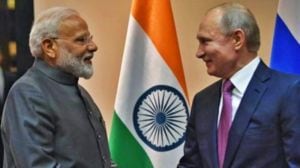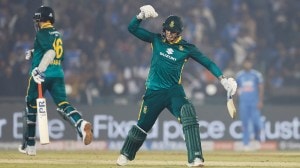Why Dera a flashpoint,sets off sparks across Punjab
The rapidity with which protests spread is a pointer to the growing clout of deras that have mushroomed across the state and their potential to spark off conflict.
It took only a few hours for fires to erupt across Punjab after the news from Vienna of serious injuries to Sant Niranjan Dass,head of Dera Guru Ravidass Sachkhand Balan,and the death of his deputy Sant Ramanand,both of whom were on a tour to Europe.
The rapidity with which protests spread is a pointer to the growing clout of deras that have mushroomed across the state and their potential to spark off conflict.
In fact,all major villages in Punjab today have two gurdwaras one frequented by the so-called upper castes or Jat Sikhs,another by Dalits or lower castes, including members of SCs and OBCs. Ironically,Sikhism was founded five centuries ago to counter the caste system. Today,its members of under-privileged communities who constitute the growing ranks of deras,each one usually headed by a living guru much against the tenets of Sikhism.
While theres no exact number of how many deras there are or how many followers they have,there are at least a dozen with a following of 1 lakh or more devotees each. Dera Sachkhand is one of them and it hasnt been in the news of late. Its leader Niranjan Dass had done little that could be seen as provocative as in the case of Dera Sacha Sauda chief Gurmeet Ram Rahim Singh who is said to have worn clothes akin to those worn by Guru Gobind Singh.
The apparent provocation for the attack on Dass could be his presence in a Vienna gurdwara and his calling the Deras inspiration Ravidass as Guru Ravidass. Vienna is considered a base for former militants and Sikh ideologues who were given political asylum during the peak of Punjab militancy. They are said to have continued backing hardliners through monetary and moral support.
The significance of these deras,including Sachkhand Balan,can be gauged from the fact that come election time,leaders of all political parties flock to dera chiefs. For,the word of the dera chief is a writ respected by followers and,therefore,they constitute committed vote banks. The legitimacy given to these deras and the steady weaning away of the faithful from the gurdwaras has often rattled the Sikh clergy and its more hardline followers pitting them against the deras.
The dera culture, as Akalis call it,has seen a steady entrenchment over the last few years. One reason is the growing assertiveness of Dalits and their call for a say in the management of gurdwaras a role that has been the exclusive preserve of the established Sikh clergy.
Dera Sachkhands history mirrors this assertiveness. Says Panjab University political scientist Ronki Ram: Dalit consciousness in Punjab,in fact,emerged against the backdrop of the teachings of Ravidass (the deras patron saint),an untouchable saint-poet of the North Indian Bhakti movement who presented a middle path between assimilation and radical separatism for the construction of a separate Dalit identity.
Social interaction levels between Jat Sikhs and Dalits may have improved but there is little change in social hierarchy involving Dalits, says Pramod Kumar,Director,Institute of Development and Communication (IDC). The feeling of being discriminated against when it comes to managing gurdwaras has added to the political voice of these deras. Deras also enjoy popular support for being at the vanguard of social causes,including a high-profile campaign against drug addiction,a major problem in rural areas.
Its not a surprise,therefore,that deras are wary of the Akalis and Shiromani Gurdwara Parbandhak Committee (SGPC). Since they preach and practise secularism,they become a natural ally of the Congress. This does not deter other politicians. Its well-known that former Chief Minister Capt Amarinder Singh and even current Chief Minister Parkash Singh Badal and his deputy Sukhbir Badal met Dera Sacha Sauda chief Gurmeet Ram Rahim Singh as well as Sant Niranjan Dass before the 2005 Assembly elections.
The deras tradition of giving the Guru Granth Sahib pride of place next to photographs and idols of their own gurus is deeply resented by the Sikh clergy,represented by the five high priests and the SGPC who argue that Sikh tenets dont provide for worshipping living gurus,idols or photographs. So the clergy accuses the deras of weaning away followers and distorting the faith.
Dera chiefs,however,feel that Sikhs are disillusioned with the established clergys hardline tenets and the fact that the SGPC is so closely involved with politics. Its such faultlines that run across the state,just under the surface,waiting for a spark like the one in Vienna to erupt.
- 01
- 02
- 03
- 04
- 05































